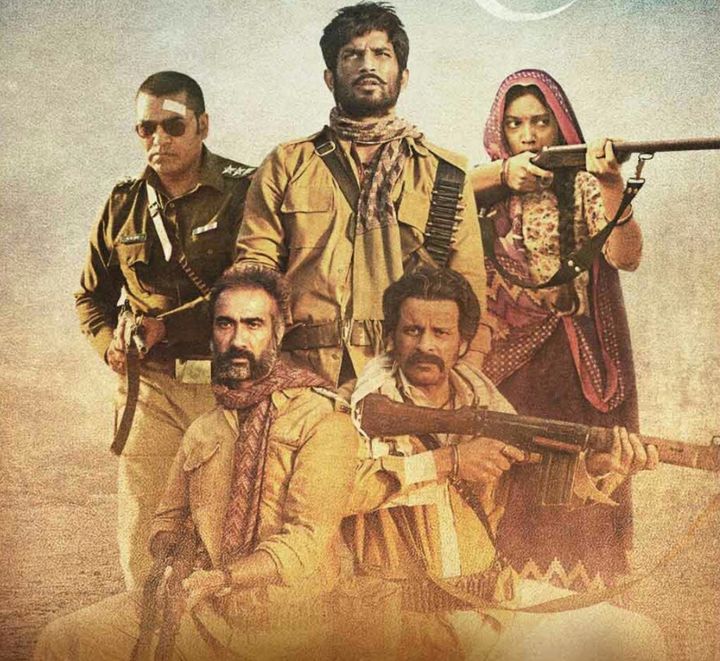
In what is undeniably the standout scene of Sonchiriya, a woman encounters a band of dacoits while traversing through the ravines of Chambal. Her first instinct is to cover her face with the ghungat (veil) before brandishing her gun and pointing it at the men.
That one scene encapsulates Abhishek Chaubey’s fiery new Western, Sonchiriya, a biting critique of caste, gender norms, and patriarchy which owes much of its stylistic references to Sergio Leone’s The Good, the Bad, and the Ugly.
Set against the backdrop of the Indira Gandhi-sanctioned Emergency, Sonchiriya takes one into the expansive, arid, balding ravines of the infamous region of Chambal, Madhya Padesh where dacoit Man Singh (Manoj Bajpayee) still calls the shots and his two trusted aides, Vakil Singh (Ranvir Shorey) and Lakhna (Sushant Singh Rajput) latch on to his every word.
When Bajpayee is murdered by hotheaded cop Vijender Singh Gujjar (Ashutosh Rana, reliably good) in an attempted robbery that’s sabotaged by the police, the gang collapses over ideologies, karma, and dharma, splitting in two, one lead by Shorey, the other by Rajput.
Director Abhishek Chaubey (Ishqiya, Udta Punjab) and writer Sudip Sharma capture the milieu of rural Madhya Pradesh with stunning precision. From the body language of the actors to the specificity of their dialect, Chaubey puts together an outstanding ensemble and trains his lens on the depressing bareness of the region with remarkable authenticity and crackling one-liners that brim with black humour.
With Sonchiriya, Chaubey’s attempt isn’t to tell dramatic tales of murders and robberies but explore the moral conflicts and internalised trauma of both, the dacoits and the cops. In that sense, Sonchiriya is a deeply spiritual film (“Will run away from the gang, how will I run away from myself?”) a quietly understated drama that is interested in understanding how gender, caste, patriarchy intersect to make monsters out of ordinary men. Chaubey’s film is a critique of a society that enables patriarchal norms to remain unchallenged.
Although women remain its biggest victims, the filmmaker gently reveals how men suffer the consequences of archaic social structures that embed a form of dangerous masculinity, which is passed on, as the film reveals in a haunting scene later on, from one generation to the next, from father to son.
In a yet another standout scene from the movie, a bunch of dacoits gaze at the stars, dreaming of a future where they live a life of dignity after serving jail time. It’s a combination of dark humour and tragedy and singularly humanises the rebels as people who aren’t evil by design but who’ve been disenfranchised from a rigid social order.
In carefully exploring the motivations and the psyche of the dacoits, Chaubey and Sharma create a moral universe where you root for their redemption as they embark upon a treacherous journey to correct, undo, and atone for sins of an unforgettable past.
Aesthetically, the film borrows elements of a quintessential Spaghetti Western while carrying the pace of a pulsating action thriller. Tonally consistent, Anuj Rakesh Dhawan’s cinematography immerses the viewer into the airless and desolated world of Chambal while Benedict Taylor and Naren Chandavarkar’s haunting score heightens the bleak and bare realities of the characters.
Which brings us to the central theme that propels the film’s narrative and triggers its inherent conflict. As much as the film is about outlaws seeking salvation, Sonchiriya is also a vital story of abuse.
Bhoomi Pednekar, who plays Indumati, escapes domestic violence and abuse. She is carrying on her shoulders a young girl from a lower-caste, who too, has been brutalised. As the film’s character inspired by Phulan Devi would reveal, the caste-system is designed to segregate the men. The women fall outside of it, right at the very bottom. It’s a chilling scene that is telling of the filmmaker’s intention, a biting critique of gender and caste and broadly, a statement on how women, especially from the Dalit community, are often left out of mainstream conversation and are in all likelihood the worst affected. It also binds together the movie cohesively, completing individual character journeys and bringing them into one collective whole.
From Ranvir Shorey’s raging Vakil Singh to Rajput’s calm-headed Lakhna to Bhumi Pednekar’s vulnerable yet levelheaded Indumati, the film features top notch performances from the entire ensemble.
Given that the Ronnie Screwvala production doesn’t boast of conventional star-power or glitzy song-and-dance numbers, the film, ironically, shouldn’t end up remaining on the fringes, just like the lives of the characters it is interested in chronicling.
As an audience of cinema, these barriers must be ripped apart, just like the film rips apart patriarchy, and one must watch the film for the profound, moving story that it is - about lost souls finding redemption and closure in the forgotten abyss of the Indian heartland.